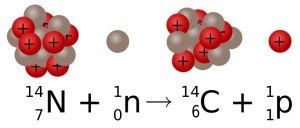Starting in the 1950s the science of Archaeology was revolutionized by the use of radioactive carbon-14 as a means of giving precise, hard dates to objects discovered during archaeological digs. Like any measuring tool however, carbon-14 (14C) dating has been, and continues to be improved in order to make its measurements more accurate, more precise and more reliable. Now a new study from researchers at Cornell and Oxford Universities seeks to further improve the accuracy of 14C dating for the Middle Eastern region by comparing it to the dates obtained by examinations of tree rings.
To understand the significance of the study let me take a few minutes to describe what 14C is and how we use it to date things. If you remember from you high school chemistry all atoms are made up of particles called protons, neutrons and electrons. The protons and neutrons reside in the very center of the atom, which is called the nucleus while the electrons fly around the nucleus. In a neutral atom the number of protons and electrons is equal and it is that number that determines what kind of atom, what chemical element it is. For example an atom of carbon has six protons and six electrons.
The number of neutrons can vary, but if the nucleus has too few, or too many neutrons it will be radioactively unstable. For carbon the stable number of neutrons is either six, making carbon-12 (12C) which makes up almost 99% of the cosmic abundance, or seven making carbon-13 (13C) at a little over 1%.
With eight neutrons carbon-14, (14C) is radioactive with a half-life of 5568 years. This means that if you had a thousand atoms of 14C in 5568 years you would only have 500 atoms of 14C left. Then in another 5568 years (11136 years total) you would only have 250 atoms of 14C. This having goes on every 5568 years until the 14C is gone. The image below shows the decay of a 14C atom.

But if 14C shrinks by half in just a few thousand years, how is there is any left? After all the Earth is billions of years old isn’t it? Shouldn’t the 14C be all gone by now?
It would have, if not for the solar wind striking the top of our atmosphere which produces a small amount of 14C all of the time. This trace of 14C drifts down into the lower atmosphere where it is absorbed into plants during photosynthesis. The image below shows the reaction that produces 14C.

Animals, like us, then eat the plants so some radioactive 14C gets absorbed into our bodies. (That’s right, you are radioactive. Well a little bit!) The ratio of 14C to 12C can be measured. When the animal or plant dies the 14C begins to decay, half of it disappearing every 5568 years. If you measure the ratio 14C/12C in organic material you can calculate how long it’s been dead! This was what scientists first thought 70 years ago.
Turns out it wasn’t quite that easy. You may also remember from high school that the Sun has an eleven year Sunspot cycle and that cycle, along with other factors alter the amount of 14C produced each year leading to some small inaccuracies. Because of this scientists have done a lot of work over the years in order to develop calibration factors that improve both the accuracy and precision of 12C dating.
The new study is one such attempt at a better calibration. The study consisted of taking samples from tree rings of a historically known date. For example if a building in Jerusalem is documented to have been built in 1830, wood used in its construction would have been cut down in 1829 and if you count in 100 rings from the last ring you then have material from the year 1729. Measuring the age of that material using 14C and by comparing that date to 1729 you get a calibration of 14C dating in Jerusalem.
That’s a part of the issue, the study from Cornell have found discrepancies between 14C dates in the Middle East and similar studies in other parts of the northern hemisphere. The researchers have found an average of a 19-year variation over the period 1610 to 1940CE. They speculate that the reason could be tied to the fact that the growing season for agriculture in the Middle East is actually during the winter rather than the summer as in Europe and Asia. The question is however, if the dates from 400 years ago are off by 19 years what about the date of something from say 3,000 years ago?
That would be nice to know because as it happens a very important find has recently been dug up at the archaeological site Abel Beth Maacah in northern Israel. The find is a 5cm tall figure of the head of a man, see image below. The head is made of a glass like material called faience and is almost certainly that of a high noble if not a king.

The find has been 14C dated to the 9th century BCE when a village called Abil al-Qamh was the crossroads of three biblical kingdoms, Tyre, the Aramean kingdom based in Damascus and Israel itself. In fact Abil al-Qamh is mentioned several times in the bible and based on the 14C date it has been suggested that the figurine may in fact be that of the well-known biblical king Ahab or that of his son Jehu. However it is just as likely that the head could be that of the Aramean king Ben Hadad or king Ithobaal of Tyre. Each of these men are mentioned in the bible so a definite identification as any one of them would be a discovery of historical as well as archaeological importance.
